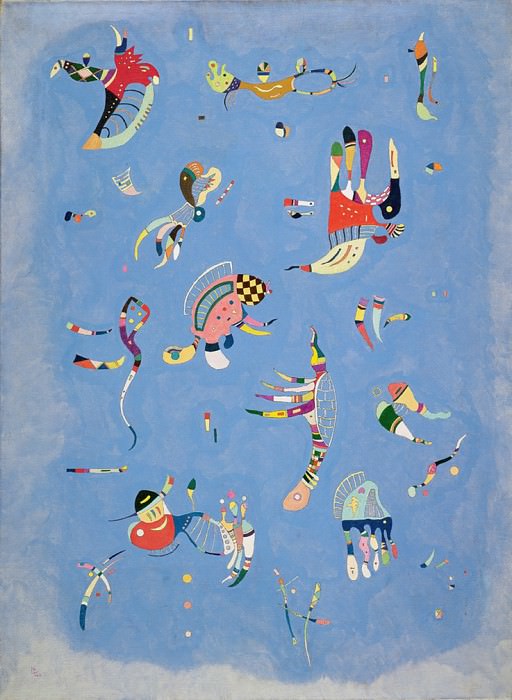Sky blue Vasily Kandinsky (1866-1944)
Vasily Kandinsky – Sky blue
Edit attribution
Download full size: 737×1009 px (0,3 Mb)
Painter: Vasily Kandinsky
Wassily Kandinsky had a talent from childhood. Despite the fact that he had studied to be a lawyer, received the title of assistant professor, and received the right to teach, Wassily makes a strong-willed decision and becomes an artist. The turning point in the life of the future artist was an accident. After Kandinsky saw a painting by Claude Monet, he decided to paint himself. His first paintings were executed in the genre of impressionism. A painting that looks like a cartoon is Wassily Kandinsky’s Blue Sky.
Description of Vasily Kandinsky’s painting "Blue Sky
Wassily Kandinsky had a talent from childhood. Despite the fact that he had studied to be a lawyer, received the title of assistant professor, and received the right to teach, Wassily makes a strong-willed decision and becomes an artist. The turning point in the life of the future artist was an accident. After Kandinsky saw a painting by Claude Monet, he decided to paint himself. His first paintings were executed in the genre of impressionism.
A painting that looks like a cartoon is Wassily Kandinsky’s Blue Sky. Since ancient times, blue has held a place of honor among other colors in art and culture. Blue is a space that has no clearly delineated boundaries. Kandinsky considered blue to be the color of peace and depth. Dark, saturated color as if calling after itself into infinity.
In the painting "Blue Sky" graphic rigor gives way to baroque motifs. In the picture we notice some creatures - these are strange figures, which seem to be floating on the sky. The artist did not even try to soften the bizarre and grotesque effect of the painting. The figures are moving, smiling. We notice a rather strange figure that looks like a kite - it stares at us in surprise. Each creature smiles. We smile back at them.
Looking at the creatures, we can’t tell if it’s the sky or the sea. The creatures also look like fish, squid and jellyfish. Kandinsky did not define them. He left it to the speculation and imagination of the viewer.
The painting doesn’t refer to abstract paintings. We do not observe here aggression, hidden conflicts.
Кому понравилось
Пожалуйста, подождите
На эту операцию может потребоваться несколько секунд.
Информация появится в новом окне,
если открытие новых окон не запрещено в настройках вашего браузера.
You need to login
Для работы с коллекциями – пожалуйста, войдите в аккаунт (open in new window).




















You cannot comment Why?
Some of the shapes are reminiscent of organic or fantastical creatures: one appears like a stylized bird with patterned wings, another a segmented, multi-limbed entity bursting with color. There are also representations that suggest human figures or body parts, such as a prominent, large hand-like form with individual fingers depicted in bright hues, and another that might be interpreted as a head with a checkered pattern. Small, rectangular shapes and scattered dots add further visual punctuation to the expanse.
The subtexts of Sky Blue are deeply rooted in Kandinskys theories of synesthesia and the spiritual in art. The title itself evokes a sense of calm, vastness, and possibly a spiritual or ethereal realm, which the blue background strongly suggests. The diverse and dynamic abstract forms can be interpreted as visual manifestations of inner spiritual or emotional states, or as musical compositions translated into color and shape. Kandinsky believed that colors and forms possessed unique spiritual vibrations that could directly affect the viewers soul. The arrangement of these playful, almost acrobatic forms against the serene blue could represent a harmonious interplay of spiritual energies, a dance of the unseen, or a journey through an abstract, celestial landscape. The overall effect is one of joyous exhilaration, a celebration of form and color in their purest, most expressive state.